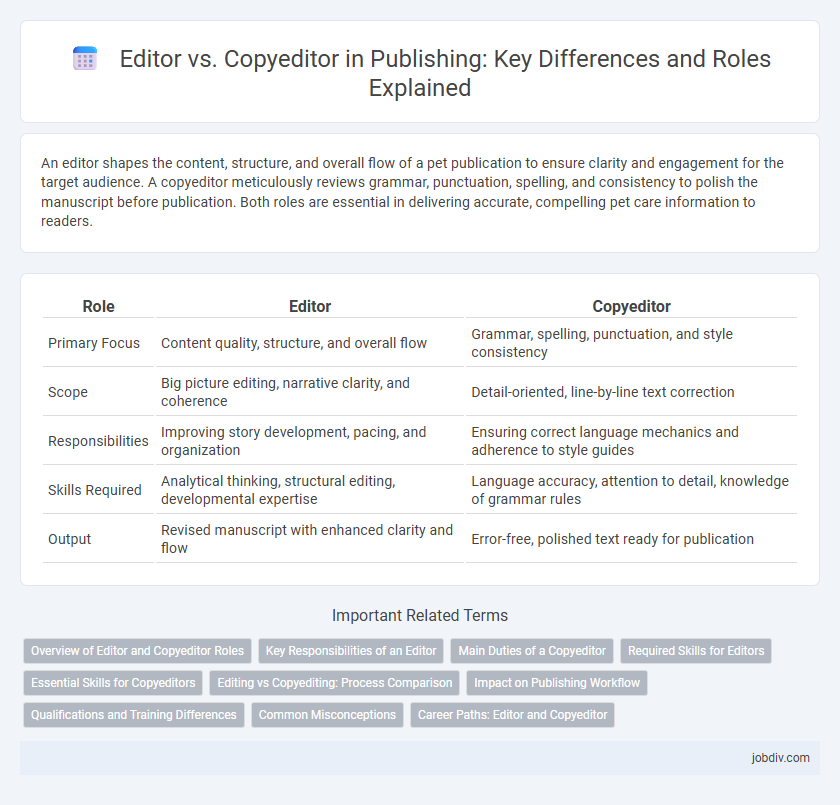An editor shapes the content, structure, and overall flow of a pet publication to ensure clarity and engagement for the target audience. A copyeditor meticulously reviews grammar, punctuation, spelling, and consistency to polish the manuscript before publication. Both roles are essential in delivering accurate, compelling pet care information to readers.
Table of Comparison
| Role | Editor | Copyeditor |
|---|---|---|
| Primary Focus | Content quality, structure, and overall flow | Grammar, spelling, punctuation, and style consistency |
| Scope | Big picture editing, narrative clarity, and coherence | Detail-oriented, line-by-line text correction |
| Responsibilities | Improving story development, pacing, and organization | Ensuring correct language mechanics and adherence to style guides |
| Skills Required | Analytical thinking, structural editing, developmental expertise | Language accuracy, attention to detail, knowledge of grammar rules |
| Output | Revised manuscript with enhanced clarity and flow | Error-free, polished text ready for publication |
Overview of Editor and Copyeditor Roles
Editors oversee the overall content, structure, and clarity of a manuscript, ensuring the narrative flows logically and meets the publication's standards. Copyeditors focus on grammar, punctuation, spelling, and style consistency, refining the text for accuracy and readability. Both roles are essential in the publishing process, with editors shaping the work's substance and copyeditors polishing the final draft.
Key Responsibilities of an Editor
An editor oversees the overall content quality, structure, and coherence of a manuscript, ensuring clarity, consistency, and alignment with the publication's style and target audience. Editors manage the developmental process by collaborating with authors, making substantive revisions, and guiding the narrative flow. Their key responsibilities include fact-checking, approving final drafts, and coordinating with other publishing team members to maintain editorial standards.
Main Duties of a Copyeditor
Copyeditors focus on refining the manuscript by correcting grammar, spelling, punctuation, and syntax errors to ensure clarity and consistency. They enforce style guidelines, verify facts, and enhance readability without altering the author's voice. Their main duties include preparing the text for the final stages of production, improving overall accuracy and coherence in published materials.
Required Skills for Editors
Editors require strong leadership and communication skills to guide authors through revisions while maintaining the overall vision of the publication. Expertise in content organization, tone consistency, and fact-checking ensures clarity and accuracy in the final manuscript. Familiarity with style guides like Chicago or APA and proficiency in digital editing tools are essential for efficient workflow management.
Essential Skills for Copyeditors
Copyeditors require a keen eye for detail to identify and correct grammatical, spelling, and punctuation errors while maintaining the author's voice and style. Proficiency in language rules, strong organizational skills, and familiarity with style guides like APA, Chicago, or MLA are essential. Effective communication abilities enable copyeditors to collaborate with editors and authors, ensuring clarity, consistency, and accuracy in the final manuscript.
Editing vs Copyediting: Process Comparison
Editing involves reviewing and restructuring content for clarity, coherence, and overall flow, focusing on enhancing the manuscript's narrative and style. Copyediting concentrates on correcting grammar, punctuation, spelling, and consistency errors, ensuring adherence to style guides and factual accuracy. Both processes are crucial in publishing, with editing shaping the manuscript's quality and copyediting refining it for publication readiness.
Impact on Publishing Workflow
Editors shape the overall content, structure, and tone of manuscripts, ensuring clarity and coherence for the target audience. Copyeditors focus on refining grammar, punctuation, style consistency, and factual accuracy to enhance readability and professionalism. Their combined efforts streamline the publishing workflow by reducing errors, improving manuscript quality, and accelerating the production timeline.
Qualifications and Training Differences
Editors typically possess advanced degrees in English, journalism, or communications and receive extensive training in content development, narrative structure, and style consistency. Copyeditors often hold certifications from professional bodies like the American Society of Professional Editors and undergo specialized training in grammar, punctuation, formatting, and fact-checking. The distinction in qualifications impacts their roles, with editors shaping the manuscript's overall vision while copyeditors ensure technical accuracy and adherence to publishing standards.
Common Misconceptions
Editors shape content structure, tone, and overall narrative flow, while copyeditors focus on grammar, punctuation, spelling, and consistency to ensure clarity and accuracy. A common misconception is that editors and copyeditors perform identical tasks, but their roles differ significantly in scope and purpose within the publishing process. Understanding this distinction enhances collaboration and improves the quality of the final manuscript.
Career Paths: Editor and Copyeditor
Editors typically oversee the content development, structure, and overall quality of manuscripts, managing projects from initial submission to final publication, which requires strong leadership and decision-making skills. Copyeditors specialize in refining text by correcting grammar, punctuation, spelling, and consistency, ensuring clarity and adherence to style guides, often functioning as a critical quality control step before publication. Career paths for editors often lead to senior editorial roles, acquisitions, or publishing management, while copyeditors may advance into senior copyediting, proofreading, or transition into editorial positions with experience.
Editor vs Copyeditor Infographic

 jobdiv.com
jobdiv.com